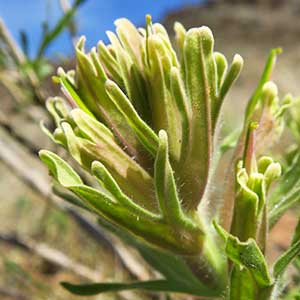Castilleja xanthotricha
Castilleja leschkeana
John Day or yellow-hairy paintbrush, John Day paintbrush, yellow hair paintbrush, yellow-hair Indian paintbrush
Leschke's paintbrush
few to several, ± decumbent to erect or ascending, unbranched, sometimes with short, leafy axillary shoots, hairs erect to spreading, long, soft, eglandular, mixed with short stipitate-glandular ones.
several, erect, decumbent at base, unbranched proximally, branched distally, glabrous proximally, hairy distally, hairs sparse, short, stiff.
green, linear, lanceolate to broadly lanceolate, oblong, or cuneate, 0.8–5 cm, not fleshy, margins plane to wavy, involute, 0–5-lobed, apex acute, sometimes rounded;
lobes spreading, linear, arising below mid length, nearly as broad as center lobe, apex acute.
green, proximal linear, reduced, middle and distal lanceolate to narrowly elliptic or ovate, proximal 0.5–1.5 cm, middle 6–7 cm (0.8–1.5 cm wide), distal 4–6 cm (2.5–2.3 cm wide), not fleshy, margins plane to sometimes ± wavy, ± involute, 0–3-lobed, apex acute;
lobes ascending, lanceolate, apex acute or acuminate.
3–14 × 1.5–4.5 cm;
bracts proximally greenish, rarely dull reddish purple, distally white to cream, rarely pale yellow or dull, pale pink (sharply differentiated from proximal coloration), lanceolate or oblong to narrowly ovate, (3–)5–7-lobed;
lobes ascending, linear to obovate, ± broadened distally, medium, long, proximal lobes arising below mid length, central lobe apex broadly rounded to truncate, others acute to rounded.
10–14+ × 6 cm;
bracts proximally dull greenish to dull brownish, distally pale orange to reddish, cuneate to obovate-truncate, 3–5(–9)-lobed, with white, stiff hairs mostly along veins;
lobes ascending to erect, broadly lanceolate or oblong, medium length, arising at or above mid length, center lobe apex rounded, sometimes toothed, others acute to sometimes rounded.
curved, 17–23 mm;
tube 15–19 mm;
beak exserted, adaxially green, 5–8(–9) mm, puberulent, stipitate-glandular;
abaxial lip deep purple (color sometimes visible through calyx), green, pinkish, or pale yellow, ± prominent, slightly inflated, usually hidden in calyx, sometimes right at top of calyx, 2 mm, ca. 50% as long as beak;
teeth ascending, whitish, yellowish, pink, or green, 1–1.5 mm.
straight, 25–30 mm;
tube 12–15 mm;
beak subequal or ± exserted, adaxially green, 12–15 mm;
abaxial lip deep green, reduced, strongly saccate-corrugated, 1.5 mm, 10% as long as beak;
teeth incurved, reduced, green, 1 mm.
colored as bracts, 15–26 mm;
abaxial and adaxial clefts 3.5–7 mm, 25–50% of calyx length, deeper than laterals, lateral 2–5 mm, 12–25% of calyx length;
lobes linear, oblong, or narrowly triangular, center lobe apex usually rounded, lobes acute to rounded.
distally reddish, 20–28 mm;
abaxial and adaxial clefts 12–15 mm, 50–60% of calyx length, deeper than laterals, lateral (0–)2–6 mm, 0–25% of calyx length;
lobes lanceolate, apex acute.
= 48.
Castilleja xanthotricha
Castilleja leschkeana
Castilleja xanthotricha is endemic to moderate elevations in the sagebrush hills of the John Day River drainage in north-central Oregon. N. H. Holmgren (1971) hypothesized that this tetraploid species is of allopolyploid hybrid origin between C. glandulifera and C. oresbia.
(Discussion copyrighted by Flora of North America; reprinted with permission.)
Castilleja leschkeana was based on a 1947 specimen from a swale near the radio station on Point Reyes Peninsula in Marin County. It was found again in 1960, but the species has not been seen or collected since then. The type specimen of C. leschkeana was identified as the Alaskan species C. chrymactis by T. I. Chuang and L. R. Heckard (1993), who considered the California population to be an accidental introduction. However, the flowers of C. leschkeana are shorter than those of C. chrymactis, with a shorter beak that is scarcely exserted. The bract blade and bract lobes of C. leschkeana are shorter, and the pubescence of its bracts is very different, short-hispid and more prominent along the veins than on the blades, contrasting with the longer and soft-villous pubescence of C. chrymactis. M. Wetherwax et al. (2012) agreed that the Point Reyes specimen was misidentified as C. chrymactis, but they were hesitant to place it in any accepted California taxon. Castilleja leschkeana is here recognized as another narrow endemic, worthy of conservation concern if it is relocated.
(Discussion copyrighted by Flora of North America; reprinted with permission.)


